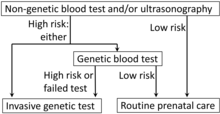
Back اختبار ما قبل الولادة Arabic Diagnòstic prenatal Catalan Prenatální diagnostika Czech Sgrinio cyn-geni Welsh Fosterdiagnostik Danish Pränataldiagnostik German Προγεννητικός έλεγχος Greek Prenaskaj enketoj Esperanto Diagnóstico prenatal Spanish آزمایش پیش از تولد Persian
| Prenatal testing | |
|---|---|
| Synonyms | Prenatal screening, prenatal diagnosis, genetic testing |
| Purpose | To monitor maternal and fetal health and progression, as well as, detect fetal abnormalities during pregnancy. |
Prenatal testing is a tool that can be used to detect some birth defects at various stages prior to birth. Prenatal testing consists of prenatal screening and prenatal diagnosis, which are aspects of prenatal care that focus on detecting problems with the pregnancy as early as possible.[1] These may be anatomic and physiologic problems with the health of the zygote, embryo, or fetus, either before gestation even starts (as in preimplantation genetic diagnosis) or as early in gestation as practicable. Screening can detect problems such as neural tube defects, chromosome abnormalities, and gene mutations that would lead to genetic disorders and birth defects such as spina bifida, cleft palate, Down syndrome, trisomy 18, Tay–Sachs disease, sickle cell anemia, thalassemia, cystic fibrosis, muscular dystrophy, and fragile X syndrome. Some tests are designed to discover problems which primarily affect the health of the mother, such as PAPP-A to detect pre-eclampsia or glucose tolerance tests to diagnose gestational diabetes. Screening can also detect anatomical defects such as hydrocephalus, anencephaly, heart defects, and amniotic band syndrome.

Prenatal screening focuses on finding problems among a large population with affordable and noninvasive methods. Prenatal diagnosis focuses on pursuing additional detailed information once a particular problem has been found, and can sometimes be more invasive. The most common screening procedures are routine ultrasounds, blood tests, and blood pressure measurement. Common diagnosis procedures include amniocentesis and chorionic villus sampling. In some cases, the tests are administered to determine if the fetus will be aborted, though physicians and patients also find it useful to diagnose high-risk pregnancies early so that delivery can be scheduled in a tertiary care hospital where the baby can receive appropriate care.
Prenatal testing in recent years has been moving towards non-invasive methods to determine the fetal risk for genetic disorders. The rapid advancement of modern high-performance molecular technologies along with the discovery of cell-free fetal DNA (cffDNA) in maternal plasma has led to new methods for the determination of fetal chromosomal aneuploidies. This type of testing is referred to as non-invasive prenatal testing (NIPT) or as non-invasive prenatal screening. Invasive procedures remain important, though, especially for their diagnostic value in confirming positive non-invasive findings and detecting genetic disorders.[3] Birth defects have an occurrence between 1 and 6%.[4]
- ^ "Prenatal Testing". MedlinePlus.
- ^ Diagram by Mikael Häggström, MD, using following source: Jacquelyn V Halliday; Geralyn M Messerlian; Glenn E Palomaki. "Patient education: Should I have a screening test for Down syndrome during pregnancy? (Beyond the Basics)". UpToDate. This topic last updated: February 16, 2023.
- ^ Pös, Ondrej; Budiš, Jaroslav; Szemes, Tomáš (2019). "Recent trends in prenatal genetic screening and testing". F1000Research. 8: 764. doi:10.12688/f1000research.16837.1. ISSN 2046-1402. PMC 6545823. PMID 31214330.
- ^ Outcomes, Institute of Medicine (US) Committee on Improving Birth; Bale, Judith R.; Stoll, Barbara J.; Lucas, Adetokunbo O. (2003), "Impact and Patterns of Occurrence", Reducing Birth Defects: Meeting the Challenge in the Developing World, National Academies Press (US), retrieved October 1, 2023